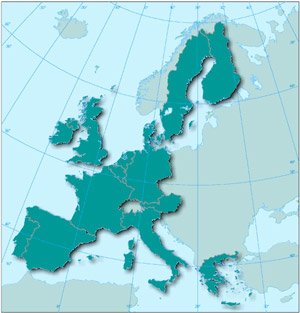Copenhagen, Denmark
December 22, 2005
 Today
the IRENA indicator report on agriculture and the environment
has been released. It provides a comprehensive overview on the
interactions between agriculture and the environment in the
European Union and is a tool for monitoring the integration of
environmental concerns into the EU Common Agricultural Policy
(CAP). Today
the IRENA indicator report on agriculture and the environment
has been released. It provides a comprehensive overview on the
interactions between agriculture and the environment in the
European Union and is a tool for monitoring the integration of
environmental concerns into the EU Common Agricultural Policy
(CAP).
The ‘Agriculture and
environment in EU-15 – the IRENA indicator report’ is one of the
outputs of the IRENA operation, which stands for “Indicator
Reporting on the Integration of Environmental Concerns into
Agriculture Policy”. It is a joint exercise between several
Commission Directorates-Generals including DG Agriculture and
Rural Development, DG Environment, Eurostat and DG Joint
Research Centre, and the
European Environment Agency that co-ordinated the project.
The project covered the 15
Member States that formed the EU in 2002. It is a response of
the European Commission to the request of the Agricultural
Council made in 2001 to develop a set of agri-environmental
indicators for monitoring progress towards the integration of
environmental concerns into the CAP. The 40 indicators produced
are based on a wide range of data sources, collected at
different geographical levels, and generally cover the period
from 1990 to 2000. The indicators help to summarise and
illustrate complex agri-environment relationships (and to
communicate them to those involved in the development and
implementation of policies, as well as to the broader public).
Thematic “storylines” are used
to illustrate the indicator results and review the effects of
farming on the environment. These include: agricultural water
use; input use and water quality; agricultural land use, farm
management and soils; climate change and air quality; and
biodiversity and landscape. The report also evaluates the
usefulness of all IRENA indicators on the basis of data-related
and conceptual criteria, such as policy relevance, analytical
soundness and ease of interpretation.
The report highlights
environmentally important trends in European agriculture, such
as the decrease of the utilised agricultural area (UAA) by 2.5%
between 1990 and 2000, affecting mainly permanent grasslands and
permanent crops. Farm-level and regional specialisation
continued during the same period, while intensification levelled
off. The overall decrease in input use, coupled with an increase
in yields, points to an increase in productivity and a more
efficient farm management. The area under organic farming
reached 3.7% of the total UAA of EU-15 in 2002, up from only
1.8% in 1998. The share of agricultural land enrolled in
agri-environmental measures – which are specifically aimed at
achieving environmental benefits on farmland – in the total UAA
increased from 20% in 1998 to 24% in 2002.
Regarding water resources,
during the last decade, the area equipped for irrigation
increased by 12% at EU level and by nearly 30% in the
Mediterranean region, although the share of agriculture in total
water use remained stable in both northern (7%) and southern
(50%) Europe, mainly due to an increase in the water use
efficiency.
There has been a general
decrease in national gross nutrient balances between 1990 and
2000, but high nutrient pressure, as measured by livestock
densities, continues to be a problem in certain regions.
Estimates of soil erosion risk
indicate that it remains a significant concern, in particular in
southern and western Spain, northern Portugal, southern Greece
and central Italy.
In 2002, the agricultural
sector contributed around 10% of total greenhouse gas (GHG)
emissions – mainly methane and nitrous oxide – although
emissions fell by nearly 9% since 1990, mainly due to a
reduction of livestock numbers, the lower use of mineral
fertilisers, and changes in farm management practices. The
report also underlines that agriculture helps reduce the
greenhouse effect through the production of bioenergy as a
substitute for fossil fuels. The emissions of ammonia also
decreased by 9%. Nevertheless, the agricultural sector still
accounted for the largest share of ammonia emissions in the
EU-15 in 2002.
Regarding biodiversity, high
nature value farmland areas – those with the richest
biodiversity – are mainly found in the Mediterranean region,
upland areas in the UK and Ireland, mountain areas and parts of
Scandinavia, and are estimated to cover around 15-25% of the
total UAA in the EU-15. The majority of farmland birds suffered
a strong decline from 1980 to 2002. This decline levelled off in
the 1990s but species diversity remains at a low level in
intensively farmed areas. Another finding is that extensive
farming systems are important for maintaining the biological and
landscape diversity, as about 18% of the habitats in Natura 2000
areas depend on a continuation of traditional agricultural
practices.
The report shows that
substantial progress in the development of agri-environmental
indicators at EU-15 level has been made. However, there are a
number of remaining challenges to fully realise the potential of
the indicators in support of the policy process.
The whole report and the
indicator fact sheets can be found on the IRENA website:
http://webpubs.eea.eu.int/content/irena/index.htm |